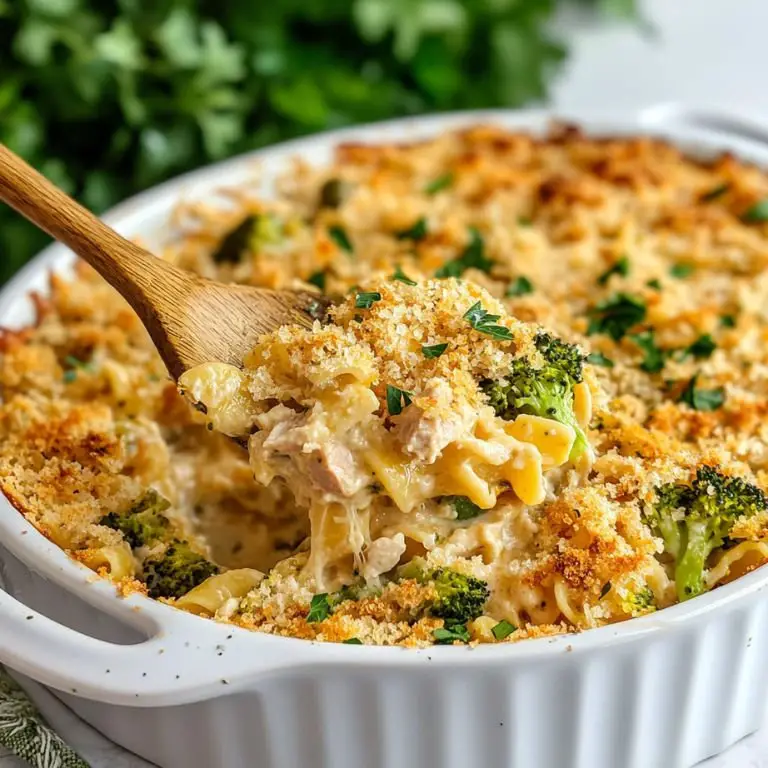
If you're craving something cozy, nostalgic, and just a little bit grown-up, this Tuna Noodle Casserole with Broccoli and Cheddar might be your new weeknight favorite. This isn't your grandma's casserole—though we do love her dearly—but rather a creamy, cheesy, and veggie-packed twist on the classic. Think of it as the Best Tuna Noodle Casserole gone gourmet: tender egg noodles folded into a velvety homemade cheddar sauce, with flaked tuna and crisp-tender broccoli in every bite. It’s comfort food that feels just a little more grown-up, but still gives you that old-school satisfaction. Whether you're into the classic Stove Top Tuna Noodle Casserole vibe or hunting for a Tuna Noodle Casserole From Scratch, this recipe delivers big flavor with simple ingredients.
When it comes to making the best Tuna Noodle Casserole, using fresh broccoli instead of frozen can make a surprising difference. Fresh broccoli brings a vibrant color, tender-crisp texture, and bright, slightly sweet flavor that frozen varieties often lack. Blanching the broccoli for just a minute or two keeps it from becoming mushy during baking while locking in its natural green color. If you're short on time, frozen broccoli is a fine substitute—just be sure to thaw it completely and pat it dry to avoid watering down your creamy sauce. But whenever possible, reaching for fresh broccoli elevates the entire dish from everyday casserole to dinner-party worthy.
The type of canned tuna you choose can change the entire personality of your casserole. Water-packed tuna is a classic pick for a lighter, cleaner flavor that lets the cheese and broccoli shine. It's lower in calories and a good choice if you’re aiming for a slightly healthier casserole.
On the other hand, oil-packed tuna delivers a richer, more luxurious taste with a melt-in-your-mouth texture. It’s especially delicious if you're after a more decadent, gourmet take on Tuna Noodle Casserole. Just remember to drain whichever tuna you use thoroughly to avoid excess moisture in the final dish. Solid white albacore gives a firmer bite, while chunk light tuna blends in a bit more, creating a softer, more integrated texture throughout the casserole.
Cheddar cheese is the heart of the sauce in this casserole, and the type you pick matters. Sharp cheddar brings bold, tangy flavor that cuts beautifully through the creamy base and complements the mild tuna and broccoli. It creates a more "grown-up" flavor profile that's complex and satisfying.
Mild cheddar, on the other hand, melts a little more smoothly and offers a softer, subtler taste, making it a great option if you’re cooking for younger eaters or anyone who prefers a milder casserole. You can even mix sharp and mild cheddar for the best of both worlds. Want to get even fancier? Try blending in a little Gruyère for nuttiness or Monterey Jack for an extra melty, creamy finish.
Tip: Always shred your cheese from a block when possible. Pre-shredded cheese often contains anti-caking agents that can prevent your sauce from turning silky-smooth.
A crunchy, golden breadcrumb topping transforms this casserole from simply cozy to completely irresistible. If you love that toasty finish, here’s how to get it just right:
Before baking, lightly toss the breadcrumbs with a drizzle of olive oil or a few spritzes of cooking spray. This helps them crisp up without drying out the casserole underneath. For even more flavor, you can mix a little grated Parmesan into the breadcrumbs before sprinkling them over the top.
This Creamy Tuna Noodle Casserole is rich and savory, so pair it with something fresh and acidic to balance it out. A simple green salad with lemon vinaigrette or a side of roasted cherry tomatoes does the trick beautifully. If you're sipping, a chilled glass of Sauvignon Blanc or a light lager cuts through the creaminess perfectly.
Craving the comfort but looking for a lighter version? It's surprisingly easy to make this Tuna Noodle Casserole a bit healthier without sacrificing the cozy, cheesy satisfaction:
These small tweaks make it easy to enjoy this nostalgic dish even on a health-focused meal plan.
One of the best things about Tuna Noodle Casserole is how well it stores and reheats, making it perfect for meal prep or busy nights.
Freezing before baking often gives the best texture when reheated, but either way, this casserole holds up beautifully.
Even a simple, nostalgic dish like Tuna Noodle Casserole can go sideways if you’re not careful. Here’s how to avoid the most common pitfalls:
Master these basics, and you’ll have a perfect, crave-worthy casserole every time!
Solid white albacore tuna holds its texture best, but chunk light tuna works well too—especially if you're going for a Tuna Noodle Casserole Easy approach.
Absolutely! Just thaw and pat it dry before mixing it in. It’s a great shortcut for a Tuna Noodle Casserole Healthy variation.
Yep! Skip the breadcrumbs and transfer everything back to the pot after mixing. Stir until heated through, and serve straight from the stove—classic Stove Top Tuna Noodle Casserole style.
Yes! Prep the entire casserole, cover, and refrigerate up to 24 hours before baking. You can also freeze it (unbaked or baked) for up to 2 months. Just let it thaw overnight in the fridge before reheating.